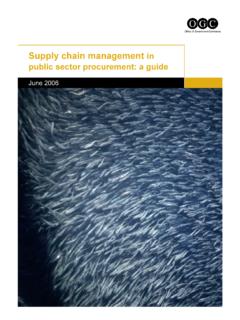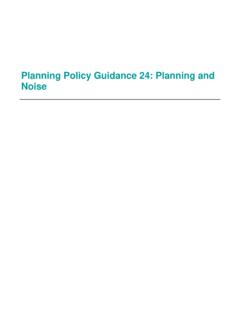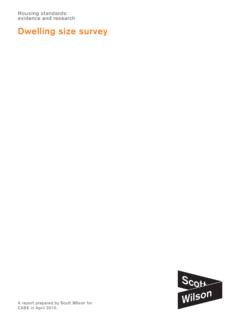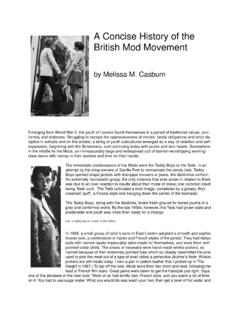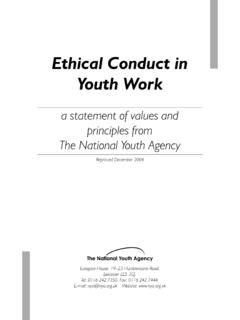Transcription of The impact of office design on business performance
1 C1 The impact of office designon businessperformanceC1 Foreword1 Introduction: Why office design matters2 Acknowledgements41 Setting the context: how the world of work is changing52 The challenge of measurement143A framework for analysis, organisation and application194 Research methodology and character315 Research findings: efficiency356 Research findings: adaptability and flexibility407 Research findings: staff performance438 Findings on external expression559 Conclusions and recommendations62 Appendix 1: Case Studies66 Appendix 2: References76 Contents1In a 2003 survey by Management Todaymagazine, virtually all(97 per cent) of those responding said that they regarded theirplace of work as a symbol of whether or not they were valued bytheir employer. Yet only 37 per cent thought that their offices hadbeen designed with people in mind , and no less a third said thatthey were too ashamed of their offices to bring back colleaguesor clients.
2 This is the kind of gap which should worrymanagement and which, were it to occur in any other disciplinein business , would almost certainly get urgent attention in theboardroom. So why do so many companies continue to dressthemselves in rags in a country which must, in the face of growinginternational competition, earn its living by its wits?The answer may be that a company s most natural response tothat same force of competition is to seek to drive down its costs and premises represent a cost that is both readily identified andreadily comprehended. As in so many facets of life, however, apreoccupation with cost may actually destroy value: but the ways in which office accommodation can create value for a business ,not just through economy but also through improving theeffectiveness of its people and broadcasting positive messagesabout its values, are inadequately study into the connection between office design andbusiness performance is therefore both important and timely.
3 Itprovides a positive route map for those facing the challenges andopportunities of addressing their business s accommodationneeds; and it does this by: summarising what we actually know, so that we can embed thislearning in good practice and avoid re-exploring the same issues summarising what more could be known, pointing to the needfor further research proposing a framework for the analysis and application ofaccommodation factors which affect business performance suggesting a standardisation of the language and protocols bywhich this subject is pursued, so that we can accumulate agrowing body of knowledge on this matter of of this will throw up easy answers, and one by-product ofthis study should be the abandonment of the very idea that theremight be a single answer to any user s question a holy grail ofoffice design . The report does, however, point the way by whichindividual users might find their answer, and demonstrates thatthe effort is those who get this wrong, the best they can hope for is amissed opportunity; and the worst is nothing less than the loss oftheir key people as a consequence of growing dissatisfactionwith their working those who get it right, the reward, if not the holy grail, can besomething almost as Morrell, BCO President and CABE CommissionerForeword2 When Frank Lloyd Wright designed a new office building for theLarkin Company in Buffalo, New York, exactly 100 years ago, hewasn t working on his own.
4 His clients were pioneers in therapidly expanding mail order business ; and they wanted a newoffice building to enhance their chances of commercial chose Wright as the best architect available to help themreinvent the workplace to take advantage of the latest ideas intechnology and management. Wright, despite his notorious ego,played a deftly handled part within a carefully directed andcompletely self-conscious managerial programme. His wonderfulbuilding, with its noble atrium, innovative environmental systems,all-round visibility, interconnectedness and inclusiveness, and itspowerful, if by today s standards somewhat paternalist, imagery,was at least as much the Larkin Company s achievement as detail in the architecture of this extraordinary building had abusiness purpose: to support a commercial strategy, toaccommodate innovative work processes, and to broadcast aparticular set of business aren t all office buildings today as purposeful as Larkin?
5 How did we get from this shining example of using architectureas the infrastructure of business achievement to where we aretoday in the land of Scott Adams melancholy comic strip,Dilbert, based on his own experience of working in the offices ofPacific Bell, where cubes and labyrinthine interiors had becomemetaphors of bureaucratic frustration? This question is the background to this study commissioned byCABE and the BCO to review the academic and scientific literaturethat has, over the last century, attempted to assess therelationship between the design of the workplace and businessperformance. Those who commissioned this report and its authors share astrong desire to apply past research to lay the foundations of arich and effective programme of study in an area of endeavourthat is by any standards, a continuing challenge to socialscientists, designers and, most importantly, is an ambitious endeavour in a complex and little understoodfield, and it is hardly an exaggeration to say that the collectivefailure to understand the relationship between the workingenvironment and business purpose puts us in the position ofearly 19th century physicians, with their limited and erroneousnotions about the transmission of disease before the science ofepidemiology had been firmly on the relationship between office design and businessproductivity has generally started from design variables and thenhas sought to establish some organisational or businessconsequence.
6 We have come to believe that one of the reasonsfor the relatively small amount of progress that has been made bysuch endeavours in this field is that this may well be the wrongstarting point. An alternative perspective, tantalising but fugitive,has been expressed occasionally by business writers such asTom Peters, who have looked at office design through the Introduction: Why office design mattersCourtesy The Frank Lloyd Wright Foundation, Taliesin West, Scottsdale, AZ3business end of the same telescope. They are far less curiousabout the consequences of design variables on business , andmuch more interested in the office design implications ofbusiness drivers and priorities. Consequently, we have conducted this study using two differentbut highly compatible analytical frameworks. The first frameworkis DEGW s three e s , a means of measuring the potential of theoffice environment to help businesses become more efficient,more effective and more expressive, The second is the widelyrespected Balanced Score Card , which we have found to be auseful means of communicating to management that the officeenvironment is more than a financial matter but is relevant tobusiness purpose in at least three other ways, in terms of humancapital, customer relations, and business process.
7 Theseframeworks have helped us to discriminate between the variousinsights that we strongly believe business people and designersshould be demanding from research on the physical workingenvironment namely: What evidence exists or should exist ofways in which office design can be used to help clients achievetheir business goals? Looking coolly at the data we have surveyed, there is certainly adisappointing lack of relevance in most office workplace researchto business performance , and we believe that a differentapproach will cumulatively lead to much more useful results. Therecommendations to developers, designers and researchers withwhich we introduce this report are based on what we see as thecrucially important benefits of a research programme that linksoffice design to business performance through maintaining asense of business purpose within a systemic single perspective can provide a complete set of answers tosuch a wide range of inherently interdisciplinary questions.
8 Anintegrated research approach is essential because research inthis complex and changing field cannot be conventionallyacademic. The experience and judgement of all of the keyconstituencies involved are vitally important to the success of anyresearch programme. As one illustration of this, the economicdimension of the results of design initiatives is obviously need to make investment decisions that are morelikely to lead to greater profit and are less susceptible to risk; andcorporate real estate managers need to demonstrate to seniormanagement the contribution that workspace can make tostimulating and supporting business success. At the same time, because of all these complexities, a robustmedium is necessary to communicate measures of theperformance of office space in relation to business goals. Forexample, the Harvard business School case study approachprovides an interesting precedent in communicating complex datainvolving many interests in a coherent and rigorous way.
9 There aremany similarities between the kind of data that are useful in thecontext of a business school, and the richness and complexity ofthe data that are necessary to explain the context, the objectives,the interplay of disciplines and interests, the timeline, the co-ordination, and the consequences that attend attempts to makethe design of offices actually work for business Duffy, DEGW4 Published by the Commission for Architecture & the BuiltEnvironment and the british Council for Offices, May on original research by DEGW, the Centre for BuildingPerformance and Diagnostics at Carnegie Mellon University andArup. The full report of The impact of office design on BusinessPerformanceis available to download and CABE, BCO and the project team are grateful for the supportshown by the members of the CABE/BCO steering committee,namely:Paul Morrell (Chair), Davis Langdon LLPRon German, Stanhope PLCA lexi Marmot, Alexi Marmot Associates James Steevens, CBRichard EllisBruce McVean, CABEIan Selby, BCOWe are also grateful to the other professional and interestedparties who have lent their time and expertise, directly andindirectly.
10 Paul Bartlett, Matthew Carmona, Ben Castell, RobertDalziel, John Dee, Geoff Edmunson, Richard Eisermann, MindyHadi, Bridget Hardy, Rob Harris, Barry Haynes, Ken Hope, ChrisKane, Palmyra Kownack, Kevin Leek, Peter McLennan, JeremyMyerson, Nigel Oseland, Paul Pegler, If Price, Andrew Proctor,Niels Rasmussen, Philip Ross, Ziona Strelitz, Tim Whitley, LynnWickins, Robin WorthingtonEndorsed by the british Property FederationAcknowledgements 51 Setting the context: how the world of work is changingIntroduction6 Studies into the new way of working6 The intangible economy8 Shifting areas of expense in the new economy8 Speed of organisational change9 People performance is more important than ever9 Multi-task work: arguments for club environments10and demands for better alignment of workplaces with more complex business processesExpression11 Brand and the increased value of marketing in11the New EconomyWhere can buildings have the most impact on business performance ?
